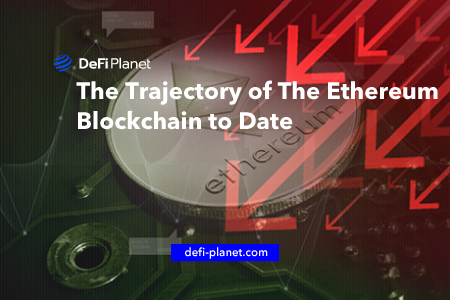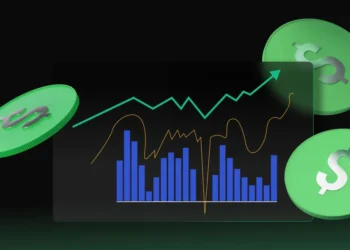Last updated on July 9th, 2025 at 10:46 am
Ethereum has come a long way since 2015, when the nineteen-year-old Vitalik Buterin introduced it as “a next-generation platform for smart contracts and decentralized applications.” The blockchain network made those bold claims a reality now as it has become the poster child for all things DeFi and dApps. It has grown into the second-largest cryptocurrency by market value, representing about 18% of the entire crypto market.
However, its journey from those humble beginnings to where it is now has not been smooth sailing. From inception to date, the Ethereum network has undergone significant upgrades that position its crypto asset to potentially outpace Bitcoin and become the dominant in the future, like some have predicted.
In this article, we’ll take a look at Ethereum’s journey so far and explore what the future might hold for this groundbreaking platform.

Major Milestones from 2015 to date
This is a timeline of all the major milestones, forks, and updates to the Ethereum blockchain
November 2013
19-year-old Vitalik Buterin published a whitepaper proposing a blockchain with a built-in Turing-complete programming language. This whitepaper quickly attracted interest, and co-founders (Gavin Wood, Charles Hoskinson, Anthony Di Iorio, Joseph Lubin) began forming a development team.
January 2014
Buterin formally presented Ethereum at a Miami conference to great acclaim. This foundational period cemented Ethereum’s identity as a platform for programmable blockchains, setting it apart from Bitcoin and seeding the community and developer interest that would fuel its launch.
April 2014
Gavin Wood published the “Yellow Paper,” detailing the technical aspects of Ethereum. . Instead of merely handling currency, Ethereum was designed for smart contracts and decentralized applications (dApps).
May 2015
An “Olympic” testnet competition was launched with a prize bounty to weed out bugs in the blockchain’s code.
July –September 2014
Ethereum’s development was funded by a novel public token sale in which held for 42 days in summer 2014.
From July 22 to Sept. 2, 2014, the Ethereum Foundation (which was set up earlier to oversee the blockchain’s development) sold Ether, the blockchain’s native token, for Bitcoin, raising about $18.3 million (31,500 BTC). The presale minted 60 million ETH (of a 72M genesis issuance) and established the initial Treasury for the non-profit Ethereum Foundation (formed July 2014).
This ICO not only provided resources but also built a large community of investors and developers.
July 2015
July 30 2015, marked the mining of Ethereum’s Genesis block and the start of the Frontier release. Frontier was a bare-bones, “alpha” release of Ethereum: it activated the network and let miners create Ether and deploy simple smart contracts. It also proved the concept of an “Ethereum Virtual Machine (EVM)” in action.
Although still rough, Frontier solidified Ethereum’s role: it was now a working general-purpose blockchain powering experiments and early ICOs. In a sense, it marked the moment when Ethereum shifted from “idea” to real infrastructure.
March 2016
As usage grew, the Ethereum community prepared a more stable release called Homestead.
In March 2016 (fork at block ~1,150,000), Homestead was activated with important protocol improvements (EIPs) to ease future upgrades and remove certain technical markers reserved for development. It also made the network slightly faster and more secure, improving transaction processing and developer tools.
June –July 2016
Spring 2016 saw the launch of The DAO, a massive decentralized investment fund on Ethereum. By June 2016, however, the DAO had a vulnerability, and attackers drained about $50 million worth of ETH from it.
In response, the Ethereum community voted on a contentious hard fork to undo the theft. On July 20, 2016, Ethereum underwent a controversial fork (at block 1,920,000) that refunded all DAO investors. This decision effectively split the network: the majority chain (Ethereum, ETH) rolled back the hack, while dissenters kept the old ledger as Ethereum Classic.
November 2017
In October–November 2017, Ethereum completed Byzantium, the first phase of the “Metropolis” roadmap. Activated at block 4,370,000, Byzantium implemented a bundle of EIPs improving privacy (zk-SNARK support), transaction speed, and lowering mining rewards (from 5 to 3 ETH).
The “Metropolis” phase was aimed at addressing the issues that arise with expansion and growth. It was devoted to enhancing Ethereum’s security, privacy, and scalability. But due to the complexities of the upgrade, it was issued in two stages, Byzantium and then Constantinople.
February 2019
After delays, Ethereum’s Constantinople hard fork (together with a companion St. Petersburg fix) went live on February 28, 2019. This upgrade further trimmed the mining reward (from 3 to 2 ETH) and introduced more efficiency EIPs (e.g. lower gas costs for some operations). By slimming down rewards and fees, it subtly shifted economic incentives and prepared the chain for the upcoming Proof-of-Stake transition.
Constantinople was mostly smooth and largely non-controversial, and it completed the originally planned Metropolis phase.
December 2019
On December 8, 2019, Ethereum activated the Istanbul upgrade at block 9,069,000.
Istanbul included six EIPs that improved interoperability and adjusted gas costs to make certain operations cheaper. It was Ethereum’s third upgrade in 2019 and the eighth overall.
With Istanbul, Ethereum strengthened resilience against denial-of-service attacks and made the EVM more efficient.
Notably, Istanbul was one of the last major “Ethereum 1.x” upgrades as the Ethereum 2.0 roadmap came into force around the time it was implemented.
December 2020 – Beacon Chain Launched (Ethereum 2.0 Phase 0)
December 1, 2020, saw the launch of the Beacon Chain, the separate Proof-of-Stake blockchain that would eventually merge with Ethereum’s mainnet. This milestone initiated Ethereum 2.0: staking went live for the first time.
Although the Beacon Chain ran in parallel (it did not yet process transactions or affect balances on Mainnet), it was crucial as a live test of PoS. Over 400,000 validators staked ~13 million ETH in the ensuing months.
The Beacon Chain’s deployment signalled Ethereum’s long-term shift to an eco-friendlier, more scalable consensus. It demonstrated commitment to the roadmap and gave developers confidence that Proof-of-Stake was viable.
August 2021
On August 5, 2021, Ethereum executed the London upgrade, which included EIP-1559. This change introduced a base fee burn mechanism: now, a portion of every transaction fee is destroyed, making ETH issuance potentially deflationary.
EIP-1559 was perhaps the single biggest economic change to Ethereum – it smoothed fee markets and made ETH scarcer over time. Early data showed that millions of ETH were burned in the months after London.
The upgrade also paved the way for new user-friendly features. London’s success signalled that the network could implement large changes smoothly, reinforcing trust.
August –September 2021
In parallel with London, Ethereum’s Layer-2 scaling saw breakthroughs. In August 2021, the optimistic rollup Arbitrum One launched its mainnet, and Optimism had earlier launched in early 2021. These Layer-2 chains suddenly offered much cheaper, faster transactions by batching onto Ethereum. DeFi and NFT traffic began shifting to L2s: by 2022, some rollups like Arbitrum held multi-billion TVL.
The success of rollups validated Ethereum’s “rollup-centric” scaling vision – Ethereum would prioritize secure data availability and settlement, while L2s provided throughput. In effect, this milestone broadened Ethereum’s capacity and ecosystem. Ethereum itself now asserted its role as a base layer for a whole network of secondary chains, vastly extending its utility.
September 2022
September 15, 2022, was Ethereum’s watershed moment: The Merge.
At that time, the Mainnet chain merged with the Beacon Chain, completely switching consensus from energy-intensive Proof-of-Work to Proof-of-Stake. This finalized the long-anticipated “Ethereum 2.0” vision.
The Merge cut Ethereum’s energy consumption by over 99% and fundamentally changed its economics. Validator staking became the sole security mechanism, and staking participation stabilized.
Community members hailed it as the first major “green” cryptocurrency. But beyond sustainability, the Merge was a statement: Ethereum had proven it could execute a massive protocol change without downtime or chain splits.
After the Merge, the net issuance of new ETH fell dramatically – in fact, on average, more ETH were burned (via EIP-1559 fees) than created, making Ethereum momentarily deflationary.
April 2023
The next step was unlocking staked ETH. On April 12, 2023, the Shanghai (execution layer) and Capella (consensus layer) upgrades — collectively called Shapella — went live. For the first time, validators could withdraw their staked ETH or rewards.
This was a significant user-experience milestone: it removed a key risk from staking (namely illiquidity) and likely encouraged more Ethereum holders to stake..
March 2023
Ethereum developers activated EIP-4337 in March 2023, and significant progress was made to improve Ethereum’s user experience by enabling smart contracts to function as wallets. This was a live implementation of the concept of “Account Abstraction.” It allowed for more flexible and secure wallet designs, including features like social recovery, multi-signature wallets, and more sophisticated transaction logic.
March 2024
In March 2024, Ethereum deployed the Dencun upgrade (sometimes called Cancun-Deneb). This introduced EIP-4844 — “Proto-Danksharding” — a major scalability enhancement.
EIP-4844 created a new transaction type with temporary “blobs” of data for rollups, vastly increasing data availability on Layer-2. In practice, this cuts L2 fees and gas costs significantly.
The upgrade rolled out on March 13, 2024, and it was the first step toward full sharding (“Danksharding”) in later years. By expanding block space, Dencun reinforced Ethereum’s role as the ultimate settlement layer: it made rollups more efficient and laid the groundwork for thousands of transactions per second in future.
In effect, this upgrade shifted the bottleneck: now, many more applications could run cheaply via L2s, bolstering Ethereum’s position as the nexus for DeFi and NFT ecosystems.
May 2025
May 7, 2025, saw the Pectra upgrade go live. Pectra packs multiple significant EIPs. It doubles Ethereum’s data-carrying capacity (2× blobs) and further reduces L2 fees, directly extending the gains from last year’s EIP-4844. It also raises the validator stake limit (making whale staking more efficient) and adds features like account abstraction (EIP-7702) to allow “smart accounts” with richer functionality.
In terms of strategy, Pectra continues Ethereum’s roadmap toward a user-friendly, high-capacity blockchain. It represents arguably the most significant update since the Merge and underscores Ethereum’s ongoing innovation.
Final Thoughts
Ethereum’s journey has been one of rapid growth and adaptation. From a bold whitepaper idea in 2013 to today’s global blockchain infrastructure, each milestone – technical or cultural – has expanded Ethereum’s capabilities and audience.
The average transaction fee is now lower (thanks to EIP-4844 and related changes), and a robust suite of Layer-2 networks carries much of the volume. Institutional usage is rising too: crypto custodians and ETFs (especially in Europe and Asia) have begun offering ETH exposure, while DeFi protocols on Ethereum increasingly serve corporate finance (real-world asset tokenization) and decentralized exchanges.
While challenges remain (scalability, competition, regulation), Ethereum in 2025 is a robust ecosystem: green, scalable via rollups, and richer for it. The network now often serves as a shared settlement and trust layer, while innovation happens on top.
As for the future, Ethereum is likely to continue leading with foundational tech (proof-of-stake security, sharding) while competing blockchains carve out niches. If past patterns hold, Ethereum will steer major trends (DeFi, NFTs, DAOs, real-world asset tokenization) for years to come.
Disclaimer: This article is intended solely for informational purposes and should not be considered trading or investment advice. Nothing herein should be construed as financial, legal, or tax advice. Trading or investing in cryptocurrencies carries a considerable risk of financial loss. Always conduct due diligence.
If you would like to read more market analyses like this, visit DeFi Planet and follow us on Twitter, LinkedIn, Facebook, Instagram, and CoinMarketCap Community.
“Take control of your crypto portfolio with MARKETS PRO, DeFi Planet’s suite of analytics tools.”























